PART ONE: ALAN TANNER’S ‘MUSIC IS THE REVOLUTION’
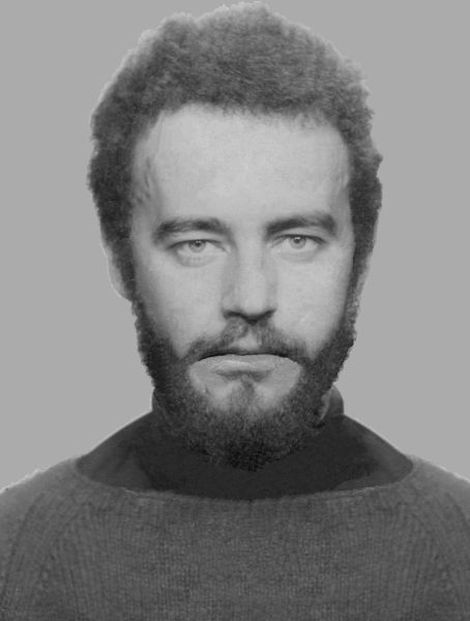
Alan Tanner in the seventies, when he worked in London’s psychedelic underground music scene.
Many people in Govanhill may be familiar with Alan, but may not be familiar with his stories. So as part of a short series for Govanhill voice we will map out some of his amazing adventures in art, and in life. So next time you see Alan you can ask more about his mad cap adventures in person!
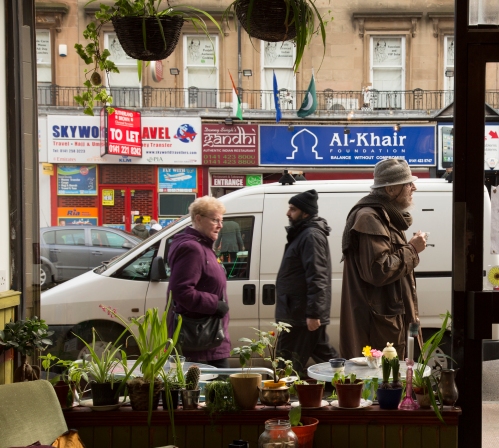
Alan outside Milk Cafe.
‘London was busy. Hopping. Everybody seemed to turn up in Notting Hill Gate; like the centre of the universe for all of us.’ ALAN TANNER
“I was living in Notting Hill Gate, London, close to Ladbroke Grove, which had turned into a magnet for all sorts of musicians, writers, artists. There was this amazing, drug-fuelled underground culture thing going on. No one had seen anything like it.
“London was busy. Hopping. Everybody seemed to turn up in Notting Hill Gate; like the centre of the universe for all of us. Jimi Hendrix, who at that time was the world’s highest-paid performer, lived just a few streets away. I’d regularly bump into him and his girlfriend.
“One of the first album covers I did was A Salty Dog for Procol Harum. A few years before they’d had a massive hit with A Whiter Shade of Pale so they were already big stars. I drew this sailor with his girl for the cover of their third album.
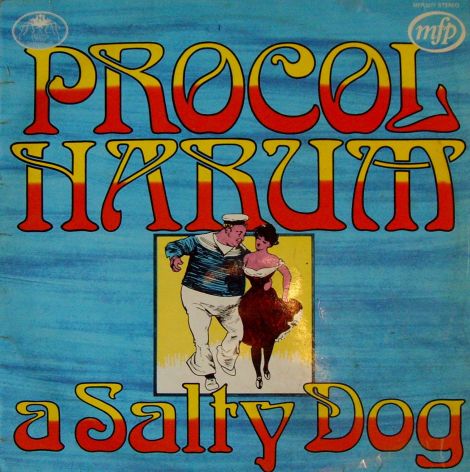
“In Notting Hill Gate I was working for a music management agency called Clearwater Productions. I was eking out a living drawing album covers and promotional art for upcoming bands like Hawkwind, Skin Alley, and an English country rock band called Cochise.

“At that time Hawkwind were almost unknown outside Notting Hill. One of their ‘roadies’ was a real character called ‘Lemmy’. They asked Lemmy to play bass because they couldn’t find anyone else. The problem was, Lemmy couldn’t play bass. So he just made noises plucking the strings…and nobody twigged he couldn’t play! Eventually Lemmy got kicked out of Hawkwind and he formed his own band, Motörhead, who were incredibly successful. Lemmy ended up as one of the best-known bass players in the world!
“In 1970 I did a drawing to promote Hawkwind’s debut album, which was just called Hawkwind. In my original drawing various ‘body parts’ of a hawk and a human skeleton were hurtling off in all directions through space, as if an explosion had blown them to pieces.
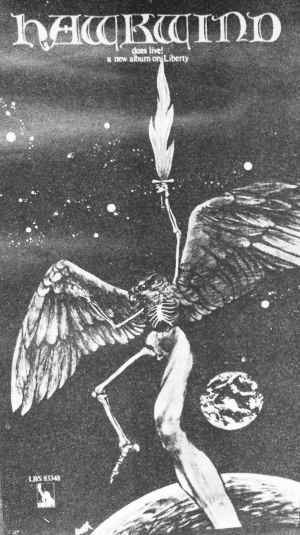
“But the band said they wanted all the parts put together again. So the final version shows this bizarre ‘creature’: a human skeleton with a hawk’s head and wings, brandishing a torch like the Roman goddess Liberty. If you look closely you’ll see its left leg still has human flesh on it! It’s nearly fifty years since I drew this but I still think my ‘exploding’ version was better!
“I knew Mike Ratledge and Robert Wyatt of Soft Machine from my early days in Canterbury. Their sax player Elton Dean was leaving to start his own group Just Us, and asked me if I’d do a cover for their debut album. So I did Scorpions. When I showed it to Elton he asked me: ‘Why scorpions?’ I said: ‘Well, why not?’ and he just said: ‘Yeah, great!’
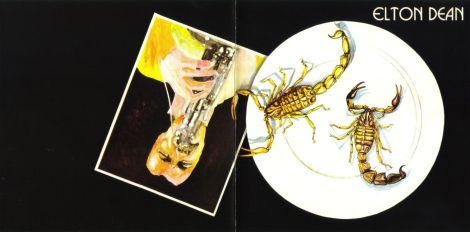
“The Groundhogs had a new album coming out called Thank Christ for the Bomb, which I thought was a good title, and they wanted me to come up with an idea that related to the First World War.”
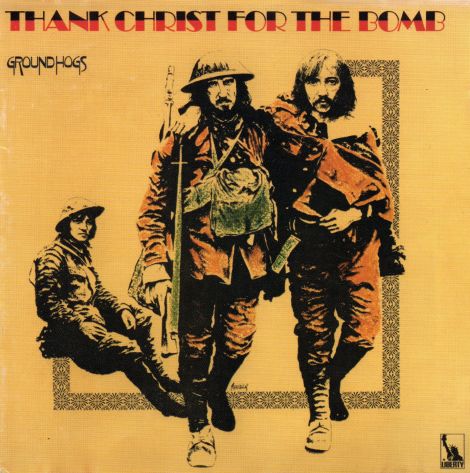
“I had a little cottage in Somerset, so I disappeared down there to do the artwork. When you open up the gatefold you see a Tiger Moth biplane soaring above a crowd, but it’s dropping poppies instead of bombs, which I thought was a nice idea.
“On the back cover there was a British Tommy in a helmet with a bomb dropping down onto his head, and the words ‘The End’ in big red letters. But the record company didn’t like that idea, so they concealed the bomb with a bit of wallpaper that had an abstract pattern on it!
I had a lot of fun doing this cover. It’s one of my favourites. And I think the lads in the band really liked it as well, because they said it was ‘great’.
“I did some stuff for OZ, probably the most infamous of all the underground magazines. One image I did was of Black Panther leader Huey Newton clenching his fist in a ‘black power’ salute. They gave me some photographs and asked me to turn them into graphics to go along with the article.
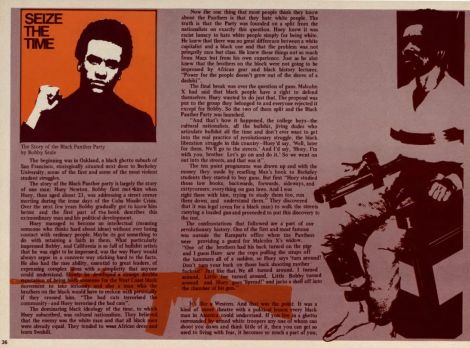
Alan Tanner’s ‘Black Panther’ artwork for a review of Bobby Seale’s book Seize the Time in OZ 31 (Nov/Dec 1970, pp.36-37)
“I spent most of my working days in London as a graphic artist with Time Out. It was a new entertainment guide that began as a double-sided A2 sheet folded down into an A5 pamphlet. They sold it to passers-by on the street for a shilling.
“At one point I was in Spain with a girlfriend who worked for Reuters, and she said to me: ‘Do you want to meet Salvador Dalí?’ and I said: ‘Of course!’ So we travelled down to Port Lligat, a pretty little fishing village where his house overlooked the bay, and we spent the day with him.
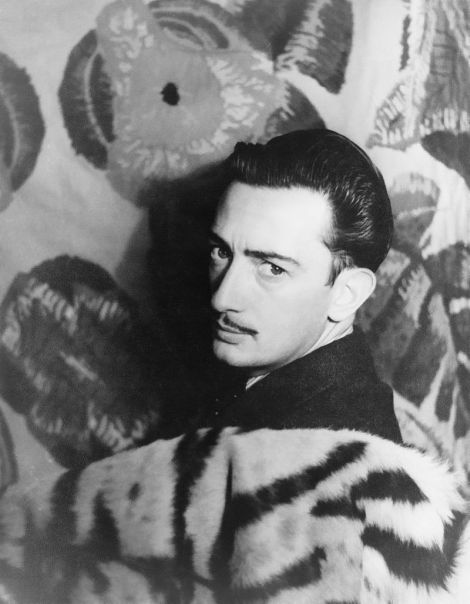
Salvador Dalí photographed by Carl Van Vechte.
“As it turned out, he was as mad as a hatter. He really was! He spent most of the day slinging cats into his swimming pool, then turning to us and saying: ‘Cats can swim!’ I already knew that! His wife Gala turned up too. Most of the time she hid behind a door, peeking out every now and then, looking at us, and then disappearing again.
“But it was an amazing house. Big eggs everywhere, all round the swimming pool. I remember Dalí getting up, walking over and just sitting in an egg. It was like he was totally encased inside this big egg. Very odd!”
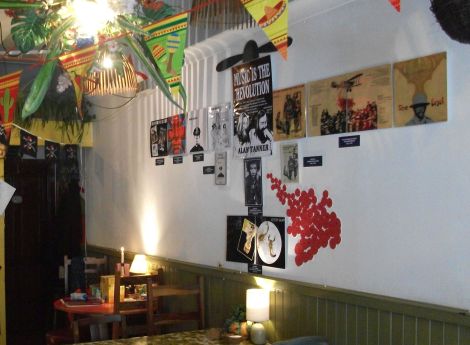
Music Is The Revolution, an exhibition of Alan Tanner’s album covers, was held last summer at the former Go Slow Café (now Milk Café), at 452 Victoria Road, Glasgow, G42 8YU.
To see the ‘Music Is The Revolution’ Gallery click here:
https://drive.google.com/folderview?id=0B8uGS8Z1EaXILUVxVVdUTU9MbTA&usp=sharing
For full details of music albums with Alan Tanner cover art, visit: https://www.discogs.com/artist/2425946-Alan-Tanner
ALAN TANNER was born in London on 22nd March 1937. He grew up in Birchington-on-Sea, a small seaside resort on Kent’s northeast coast, and attended Thanet School of Art (Margate) and Canterbury College of Art, before serving in the British parachute regiment fighting EOKA guerrillas in Cyprus. In the early seventies his surreal, dream-like imagery featured on a number of album covers for bands in London’s flourishing underground rock scene, including Procol Harum, The Groundhogs, Hawkwind, and many other legends of British counterculture. He spent a decade in London as a graphic artist, first working for the notorious OZ magazine and then the entertainment guide Time Out.
Alan Tanner’s Contact Info –
Email: alan.t.12321@gmail.com
Facebook: http://www.facebook.com/profile.php?id=100004416286681
IN PART TWO: ALAN TANNER’S ‘BUBBLE TRIP’
“I wanted out of the London rat race, and I thought: ‘Where the hell do I go?’ And somehow I just ended up in Scotland.” ALAN TANNER

When is part 2 coming. This is fascinating. Have seen alan in cafe milk but knew nothing of his history.
LikeLike
part 2 in September and part 3 in October!
LikeLike
Thanks! Will keep checking back in.
LikeLike